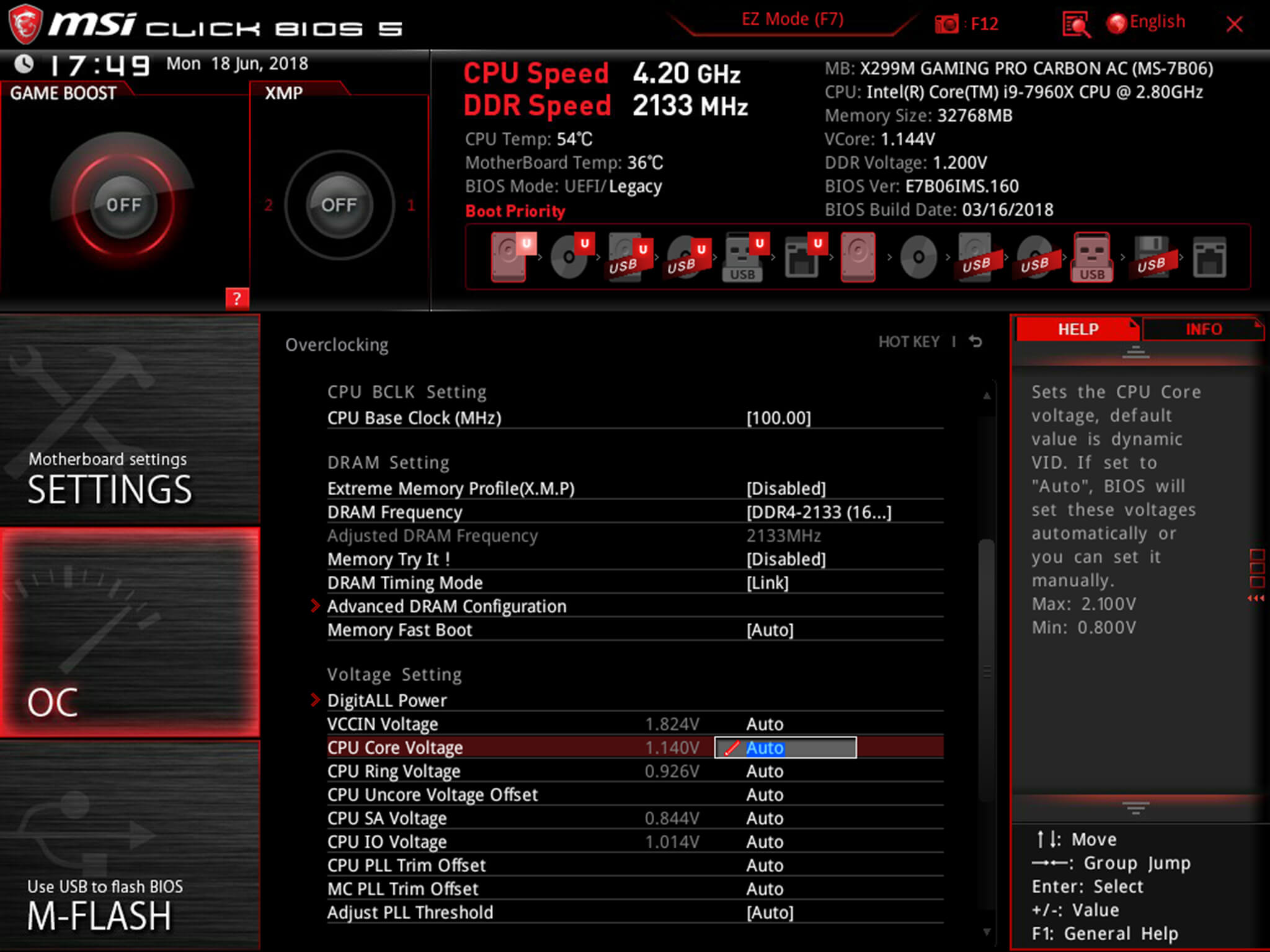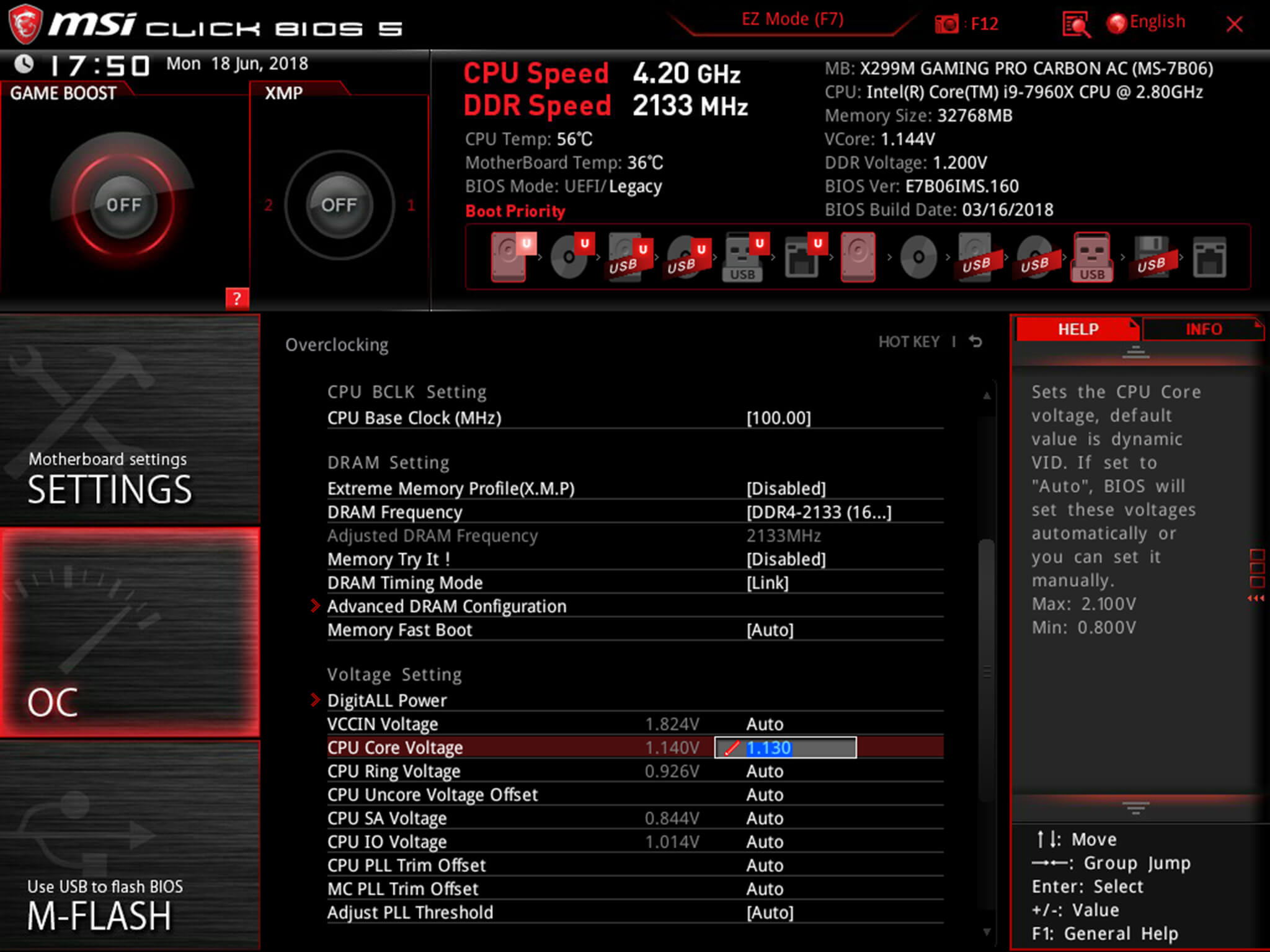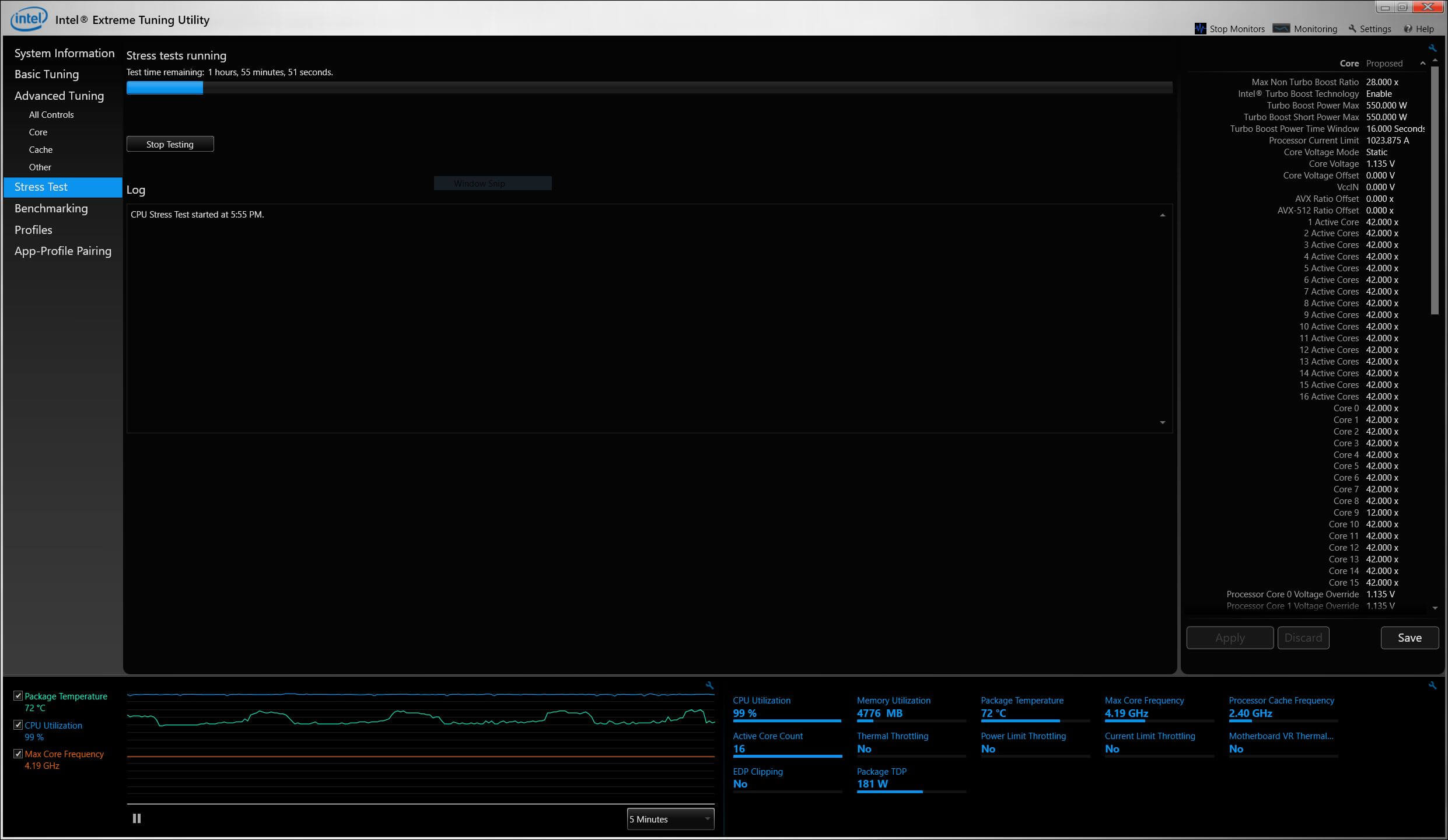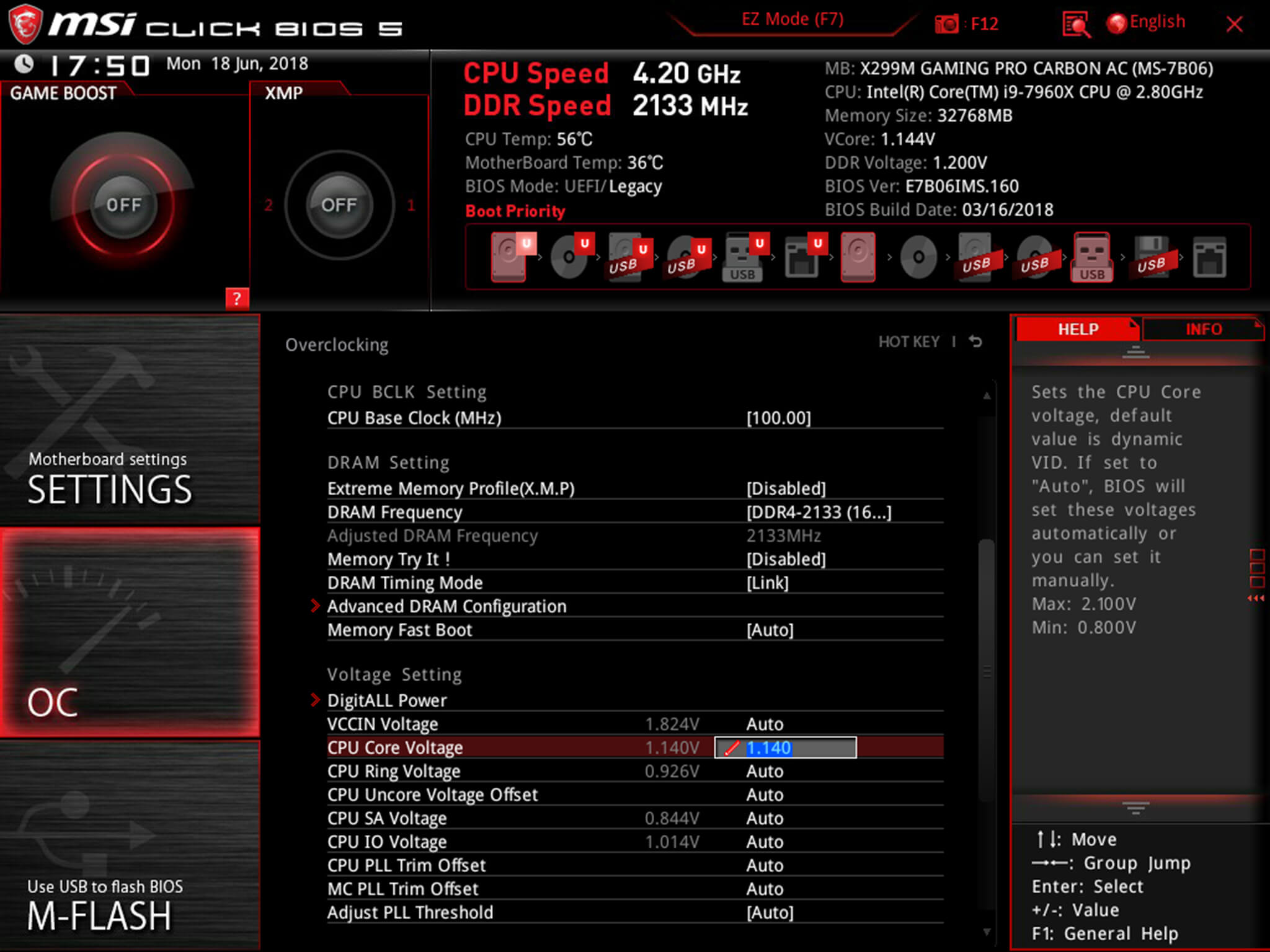The core voltage is different for each processor model, and while all CPUs of the same model have the same VID, not all samples maintain stability at the same clock speeds and Vcore due to slight variations in silicon quality. Every sample of the same CPU model is tested to maintain stability at the default speeds and the VID determined by the manufacturer.
Core voltage typically maintains a constant value while your CPU is in use; however, sometimes under heavy workloads vcore can fluctuate. This is known as Vdroop and can be corrected with load-line calibration. This applies additional voltage as load increases to maintain your CPU's stability.
When it comes to overclocking, you can only push your CPU's frequency so far before your CPU starts to experience instability. Programs might begin to crash or hang up, game performance could suffer or your computer could even fail to boot. This is because your processor isn't getting enough voltage to maintain system stability.
Increasing voltage will allow you to dial in the perfect overclock.
To adjust the voltage, you'll need to boot into your motherboard's BIOS and make adjustments there. The Vcore is expressed as a three decimal value, such as 1.235v. By default, the voltage control is set to auto; this can be overridden by typing in any value. Make sure not to exceed the recommended maximum for your processor.

Before fine-tuning the Vcore, it's important to find a good baseline value for a given speed. This varies from model to model but it can be helpful to read reviews for your CPU, specifically ones that focus on overclocking.
Most publications will list the voltage they required to keep several different speeds stable. Every CPU sample is different and you will need to fine-tune the voltage before calling it done; however, these values do provide a good starting point.

If you boot your machine and don't find any stability issues, then you know it's time to start decreasing the voltage. When overclocking, you want to find the lowest voltage required to maintain stability. More voltage equals more heat and this will allow you to keep temperatures under control.

The safest way to adjust voltage is with increments of .01 volts. Decrease voltage until your computer starts showing signs of instability under load. Use a program like Intel's Extreme Tuning Utility (XTU) or Prime95 to stress test your processor.
If the test fails or crashes, then you need to raise the voltage back up to the previous stable point. For optimal efficiency, you can increase the voltage by .005 instead and again test for stability.

Conversely, if your overclock isn't stable at your baseline voltage, you will then need to increase the voltage until your computer shows no adverse effects and then decrease in increments of .005 to fine tune.

Overclocking is not the only time it can be useful to adjust voltage. As mentioned, higher voltage levels cause your CPU to generate more heat, regardless of frequency. Some CPU samples may have a higher VID than is actually required at the default frequency. Undervolting your processor allows your to maintain stability while decreasing temperatures and extending the life of your processor.
It's a common misconception that disabling Turbo Boost is a more effective substitute for shedding heat. While this does result in decreased temperatures, it is not an alternative as the purpose of undervolting is to maintain the same level of performance while generating less heat. When making adjustments, the same principles apply here as with overclocking, decrease Vcore in increments of .01 and then fine tune with adjustments of .005.
Previous:This is the fattest of the extremely fat bears
Next:Mary Shows Up
 How to watch the Microsoft Surface event 2024
How to watch the Microsoft Surface event 2024
 Truecaller has an AI upgrade for Android users to block robocalls
Truecaller has an AI upgrade for Android users to block robocalls
 Rare frilled shark with unusual teeth and 'snake
Rare frilled shark with unusual teeth and 'snake
 'Severance' Season 3 gets confirmed by Apple
'Severance' Season 3 gets confirmed by Apple
 Apple to launch a new, 'mid
Apple to launch a new, 'mid
 How to watch the Microsoft Surface event 2024
How to watch the Microsoft Surface event 2024
 Nvidia's next
Nvidia's next
 Best soundbar deal: Save $300 on the Sonos Arc
Best soundbar deal: Save $300 on the Sonos Arc
 Wordle today: The answer and hints for March 21
Wordle today: The answer and hints for March 21
 Trump administration to allow African elephant trophies back into U.S.
Trump administration to allow African elephant trophies back into U.S.
 Best Uber deal: Save $10 on a $100 Uber or Uber Eats gift card at Best Buy
Best Uber deal: Save $10 on a $100 Uber or Uber Eats gift card at Best Buy
 YouTube now requires some AI
YouTube now requires some AI
 Skype is finally shutting down
Skype is finally shutting down
 NYT's The Mini crossword answers for March 18
NYT's The Mini crossword answers for March 18
 This parrot potty is so cute you'll almost forget it's disgusting
This parrot potty is so cute you'll almost forget it's disgusting
 YouTube now requires some AI
YouTube now requires some AI
 Best portable power station deal: Save 44% on the Jackery Explorer 100 v2
Best portable power station deal: Save 44% on the Jackery Explorer 100 v2
 Best Apple deal: Score the Apple Watch Series 9 for under $300 at Best Buy
Best Apple deal: Score the Apple Watch Series 9 for under $300 at Best Buy
Michael Herr, 1940Staff Picks: John Aubrey, Leopoldine Core, Jennifer GrotzRaving Maniac of the Cinema: Jonas Mekas’s AntiStaff Picks: John Aubrey, Leopoldine Core, Jennifer GrotzAn Interview with Jana PrikrylMemoirs of an Imprisoned SuffragetteThe Curious Case of Ernst KantorowiczThomas Mann’s Brutal Review of His Older Brother’s NovelA Very, Very Thorough Look at Blade Runner’s TypefacesSmall Talk Is America’s Greatest, Strangest Art FormDaniel Spoerri’s FleaOn the Enduring Appeal of Frederick Ashton’s La Fille Mal GardéeThe Curious Case of Ernst Kantorowicz“Bad Behavior”: An Interview with Alexia ArthursPrints by Peter HowsonLast Exit: Luc Sante Moves OutThirty MalapropismsFalling for FitzgeraldA Very, Very Thorough Look at Blade Runner’s TypefacesOne Night Only! The Implosion of the Riviera, Monaco Tower Gorgeous digital Mother's Day cards honor immigrant and Muslim moms 'Rob & Big' star mourns Big's death: 'My heart is broken' Phone charging services are on the rise, fueled by our obsessive need to keep our batteries full This handbag device will help you catch snatch thieves red What to expect at Microsoft Build 2017 What to expect from '13 Reasons Why' Season 2 Kid buys used copy of 'Grand Theft Auto,' discovers meth inside Snapchat's constant evolution shows it won't let itself be crushed by Facebook United allegedly burned dead giant rabbit's remains without consent Driverless trucks are here because no one wants to drive trucks anymore Opera adds WhatsApp and Facebook Messenger right into the browser You won't believe how fast this Microsoft plug Facebook empowers Page owners to politicize their posts How to watch the Microsoft Build keynotes Finally, someone combines a salt shaker, Bluetooth speaker and mood lighting Microsoft goes full Minority Report with Gesture API for Windows 10 Derelict house engulfed by overgrown trees is on sale for £450,000 and it's a pretty good deal Björk wants you to stop Instagramming and go to the forest Don’t believe that ‘James Comey’ pee tape tweet Why the Echo Show could be Amazon’s most disruptive product
2.8618s , 10133.5859375 kb
Copyright © 2025 Powered by 【Pehredaaar Again (2025) Hindi Web Series】,Steady Information Network